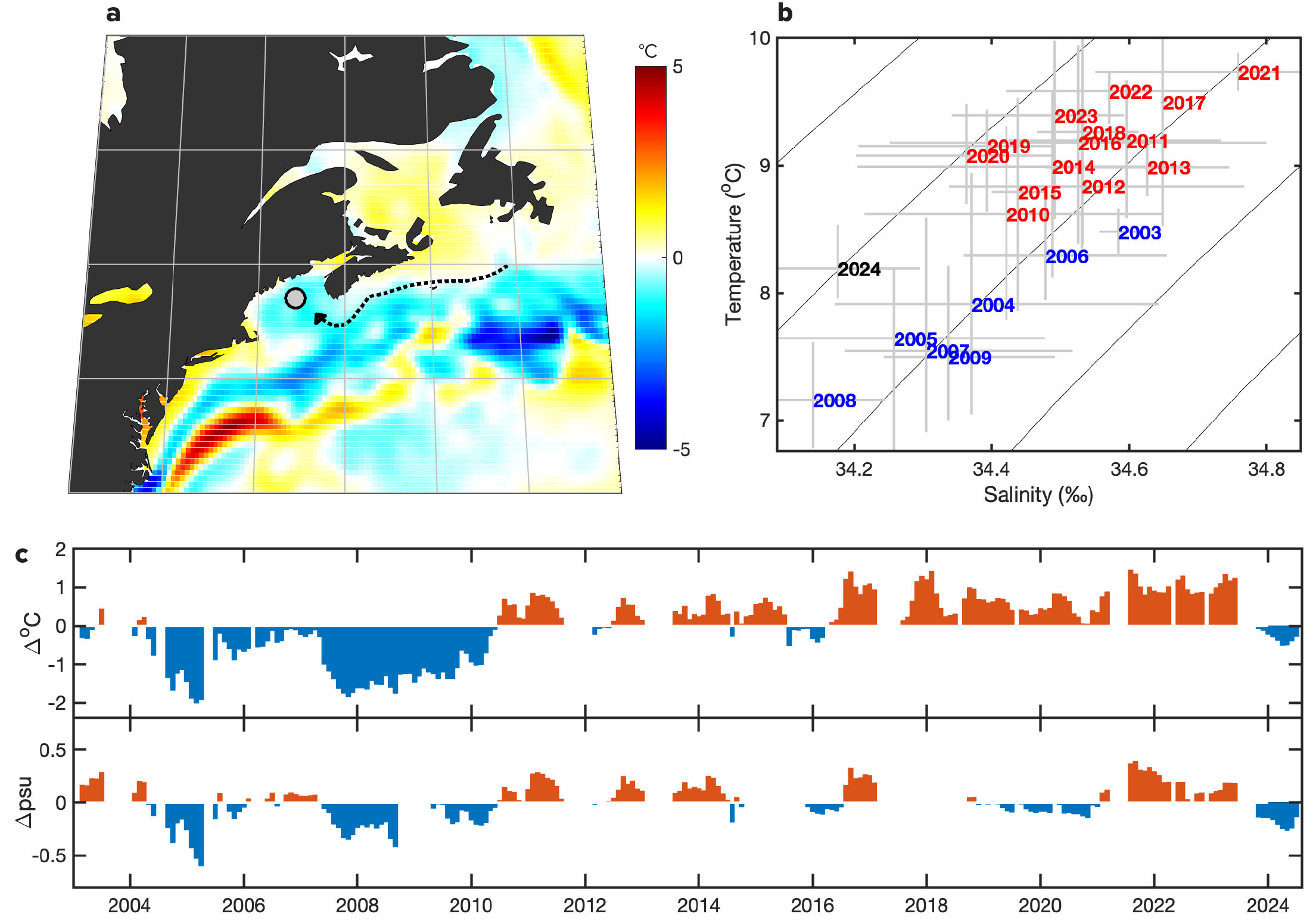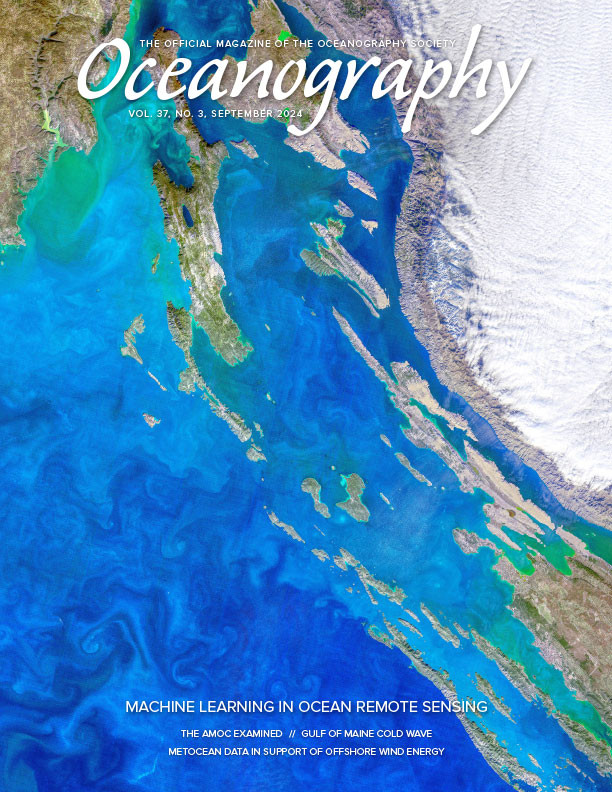The Gulf of Maine was one of the first marine ecosystems to report a major ocean heatwave, one that lasted for more than a year in 2012–2013 and reached temperatures projected for the end of the twenty-first century (Mills et al., 2013). That heatwave drove major ecological shifts, including historically low cod stocks (Pershing et al., 2015), a multi-year unusual mortality event for the endangered North Atlantic right whale (Record et al., 2019), the collapse of northern shrimp (Richards and Hunter, 2021), the near disappearance of blue mussels from the intertidal zone (Sorte et al., 2017), and other effects (Reardon et al., 2018; Scopel et al., 2019). While these impacts constituted a major surprise that drew a great deal of attention (e.g., Woodard, 2020), the consequences were documented only after the fact, highlighting the need to monitor rapid or surprising oceanographic changes as they are happening.
Subsequent research showed that the heatwave was preceded by extremely warm deep water entering the gulf through the Northeast Channel a year prior (Balch et al., 2022). The Northeast Channel is the only conduit for deep water into this shallow sea, and because of the sheer volume of water below the thermocline, the water masses that enter through this path have an outsized influence on long-term dynamics. This influence is generally a reflection of the “Coupled Slope Water System” that includes the Gulf of Maine (MERCINA Working Group, 2001) and that is tightly connected over long timescales to the deep water in the Northeast Channel (Sherwood et al., 2011). Changes in the state of this system have coincided with approximately decadal regime shifts in the Gulf of Maine ecosystem (Greene and Pershing 2007; Meyer-Gutbrod et al., 2021). Oceanographers have suggested the potential for early warnings of major changes based on upstream dynamics (Greene and Pershing, 2003; Gonçalves Neto et al., 2021). Because of the importance of subsurface currents to this process, focusing on surface conditions can mask important dynamics.
After more than a decade of consistently warming conditions, the deep water in the Gulf of Maine has a thermohaline regime not detected since before the heatwave signal appeared in 2011. A buoy in Jordan Basin has recorded water column temperatures and salinities near-continuously since 2003 (Figure 1a). Prior to 2011, mean annual temperatures at 250 m depth had ranged from approximately 7°C to 8.5°C. Since 2011, these temperatures have ranged from approximately 8.5°C to 10°C (Figure 1a). The lack of overlap between these two regimes supports the idea that the supply of water through the Northeast Channel has undergone a major shift from subarctic Labrador Slope Water to subtropical slope water associated with the Gulf Stream. The shift in salinity—a conserved property—is consistent with a change in source waters. The fact that 2024 stands out somewhat from the cluster of other cold, fresh years suggests that the colder, fresher Labrador source water, while significantly colder than it was in the past decade, is running around 1°C warmer than the historical Labrador source water of the early 2000s. This is consistent with warming in the upstream source region.

FIGURE 1. (a) Location of the Jordan Basin buoy (dot) and the general path of Labrador Slope Water into the Gulf of Maine superimposed on the winter 2024 sea surface temperature anomaly (January–March Optimum Interpolation Sea Surface Temperature [OISST] anomaly from the 30-year mean, °C). (b) Annual mean temperature and salinity conditions at 250 m depth in Jordan Basin. Gray lines show the range of monthly mean values. (c) Monthly temperature and salinity anomalies at 250 m depth in Jordan Basin. Missing values are times when no data were collected by the instrumentation. > High res figure
|
At a time when North Atlantic surface temperatures were broadly breaking record warming levels during 2023 (Hobday et al., 2023), Gulf of Maine surface conditions were running just a little above average. Meanwhile, a shift toward an input of Labrador Slope Water that began setting up during the fall of 2023 was detectable in the subsurface waters (Figure 1c). Conditions in 2024 have been consistently within the temperature and salinity ranges that characterize the pre-2011 period—conditions that had not been recorded since before the heatwave.
Based on long-term climate projections, we expect the water mass input to shift at some point back toward the previous warm and salty conditions (Brickman et al., 2021). However, we do not know when or how quickly that return will occur. Because of the large volume of water and its separation from the atmosphere, such deep-water conditions carry a lot of thermal inertia. More importantly, the winter and spring oceanographic conditions at depth have historically had strong associations with how the biology of the Gulf of Maine develops over the summer. Effects can continue into autumn, as vertical mixing carries deep waters to the surface. Thus, these conditions can serve as an early signal for potential ecological shifts in the coming months whose possible effects are described below.
NORTH ATLANTIC RIGHT WHALES. The primary prey of these critically endangered whales, the copepod Calanus finmarchicus, is strongly influenced by the supply and conditions set up by these same deep-water dynamics. During the historic cold, fresh years, C. finmarchicus was abundant in the eastern Gulf of Maine, and large numbers of right whales would aggregate annually in late summer to feed. Following the heatwave, the prey supply declined sharply and right whales began foraging elsewhere, leading to a complex chain of events that challenge our ability to manage this species and the human activities that threaten it (Davies and Brillant, 2019). Because of the timeframe of oceanographic supply and C. finmarchicus ontogeny, these late summer declines were preceded by spring shifts in deep-water conditions (Record et al., 2019). There is no guarantee that a return to pre-heatwave conditions will resupply C. finmarchicus to the eastern Gulf of Maine, as the relative importance of supply versus local dynamics is still uncertain (Pershing and Kemberling, 2024). However, in either case, it is a shift that we should be looking out for, given the sensitive state of this management issue. Targeted whale or zooplankton surveys would be helpful, as well as coordinated communication among those with eyes on the water for opportunistic sightings.
AMERICAN LOBSTERS. Deep-water conditions in spring strongly influence the timing of molt and inshore migration and rates of post-settlement survival (Goode et al., 2019) of the American lobster—a species that supports a nearly billion-dollar fishery. Changes in this phenology can drive big swings in prices, and because of the strong dependence on temperature, deep waters in spring are predictive of molt timing (Mills et al., 2017). Based on the predictive power of spring bottom temperatures, a successful forecasting strategy was developed, but operational forecasts were stopped at the request of the industry (Pershing et al., 2018). Deep-water temperatures in the coastal zone have not yet cooled to pre-heatwave conditions, but they are getting close. Such a significant shift in deep-water dynamics should be monitored for its effects on stock dynamics. In addition to ongoing buoy observations, opportunistic water column profiles or bottom-moored thermistors would fill gaps and give a more detailed map of these dynamics.
KELP FORESTS. Deep-water conditions also influence the thermodynamics of coastal waters where kelp forests prevail. Such forests—which foster biodiversity, fuel nearshore food webs, and underpin an aquaculture industry—were widespread at the turn of the twenty-first century. However, in response to unusually warm springs and summers, forests in the southwestern Gulf have since collapsed, and forests in the northeast have become less lush, with a loss of subarctic taxa (Suskiewicz et al., 2024). A temporary return to pre-heatwave conditions is unlikely to foster recovery of southern forests because they have shifted to a novel, alternative stable state, but cooler conditions may bring a banner year for kelp recruitment in the north, given the positive effects of “cold-priming” on kelp reproduction and recruitment (Liesner et al., 2020; Gauci et al., 2022). The potential effects of cooling on kelp abundance may take one or more years to manifest, so continual ecosystem monitoring will be necessary for understanding the impacts of deep-water cooling on forest resilience.
Learning how to use oceanographic conditions as early warnings is a multi-decadal learning process. Ocean and climate surprises, generally defined as mismatches between the expectations and the realities of changing conditions, have the potential to drive changes in human and natural systems (Pershing et al., 2019), and they have played a particularly important role in the Gulf of Maine (Record et al., 2023). If we hope to use real-time oceanographic measurements to prepare for future events, as some have suggested (Link et al., 2023), we are obligated to report significant events as they unfold. We don’t mean to imply that this oceanographic shift will return the Gulf of Maine to a pre-heatwave ecosystem—that is probably impossible in a world with 426 ppm CO2 concentrations (and rising). However, this type of oceanographic change has had major effects in the past, and we should be paying close attention this summer and fall as events unfold.
Acknowledgments
This work was supported by NSF grants OCE-2049308, ORCC-2307754, and OIA-1849227 and by a grant from The Louise H. & David S. Ingalls Foundation. We also acknowledge the ongoing support of NERACOOS (Northeastern Regional Association for Coastal and Ocean Observing), which makes these valuable measurements available in real time.


